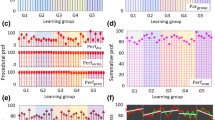Abstract
Evaluating Learners’ Response in an e-Learning environment has been the topic of current research in areas of Human Computer Interaction, e-Learning, Education Technology and even Natural Language Processing. The current paper presents a twofold strategy to evaluate single word response of a learner in an e-Learning environment. The response of the learner to be evaluated would consist of errors committed due to lack of knowledge and also out of inadvertent mistakes committed while typing the answers. The proposed system benevolently considers such errors and still marks the learner partially. The feature incorporated in this work adds the human element to the mechanised system of evaluation and assessment in an e-Learning environment.


Similar content being viewed by others
References
Abramovitz, B., & Berezina, M. (2004). Disadvantages of multiple choice tests and possible ways of overcoming them. The Mathematics Education into the 21st CenturyProject, The Future of Mathematics Education, Jun 26th–Jul 1st, 2004.
Bellegarda, J. R. (2000). Exploiting latent semantic information in statistical language modelling. Proceedings of the IEEE, 88(8), 1279–1296.
Bush, M. (1999). Alternative marking schemes for on-line multiple- choice tests. 7th Annual Conference on the Teaching of Computing, Belfast.
CAA Center (1999) Designing effective objective test questions: an introductory workshop. Loughborough University, 17th Jun 1999.
Chakraborty, U., K., & Roy, S. (2010). Neural network based intelligent analysis of learners’ response for an e-Learning environment. Proceedings of 2nd ICETC 2010, Vol. 2, pp. 333–338, Shanghai, China.
Chakraborty, U., K., & Roy, S. (2011). Fuzzy automata inspired intelligent assessment of learning achievement. Proceedings of 5th IICAI 2011, pp. 1505–1518.
Eason, G., Noble, B., & Sneddon, I. N. (1955). On certain integrals of Lipschitz-Hankel type involving products of Bessel functions. Philosophical Transactions of the Royal Society London, A247, 529–551 (references).
Evens, M. W., Brandle, S., Chang, R.-C., Freedman, R., & Glass, M. (2001). CI R C S I M-Tutor: An intelligent tutoring system using natural language dialogue. 12th Midwest AI and Cognitive Science Conference, Oxford OH, pp. 16–23.
Fabian, R., Craciunean, V., & Popa, E. M. (2006). Intelligent system modelling with total fuzzy grammars. Proc. of the 8th WSEAS Int. Conf. on Mathematical Methods and Com- putational Techniques in Electrical Engineering, Bucharest, October 16–17, 2006, pp. 82–87.
Foltz, P. W., Laham, D., & Landauer, T. K. (1999). Automated essay scoring: Applications to educational technology. In Proc. of the ED-MEDIA’99 conference, Charlottesville: AACE.
Gill, M., & Greenhow, M. (2007). Learning via online-mechanics tests: update and extension. Proceedings of The Science Learning and Teaching Conference 2007, 19–20 Jun 2007, England: Keele University, pp. 34–39.
Graesser, A. C., Wiemer-Hastings, K., Wiemer-Hastings, P., & Kreuz, R. J. (1999). AutoTutor: a simulation of a human tutor. Cognitive Systems Research, 1(1), 35–51.
Graesser, A. C., Person, N., Harter, D., & the Tutoring Research Group. (2001a). Teaching tactics and dialog in AutoTutor. International Journal of Artificial Intelligence in Education, 12, 257–279.
Graesser, A. C., VanLehn, K., Rose, C., Jordan, P., & Harter, D. (2001b). Intelligent tutoring systems with conversational dialogue. AI Magazine, 22, 39–51.
Graesser, A. C. et al. (2003). Why/AutoTutor: A test of learning gains from a physics tutor with natural language dialogue. In Proc. 25th AnnualConference Cognitive Science Soc., pp. 1–6.
Graesser, A. C., Chipman, P., Haynes, B. C., & Olney, A. (2005). AutoTutor: an intelligent tutoring system with mixed-initiative dialogue. IEEE Transactions on Education, 48(4), 612–618.
Gray, W.D. & Altmann, E.M. (2001) Cognitive modeling and human computer interaction. In W. Karwowski (Ed.), International encyclopedia of ergonomics and human factors, 1, 387–391. New York: Taylor & Francis, Ltd.
Halverson, T. (2006). Integrating Models of human-computer visual interaction. Proceedings of Conference on Human Factors in Computing Systems-2006, ACM, pp. 1747–1750.
Hussain, S., & Naseem, T. (2013). Spell checking. www.panl10n.net/Presentations/Cambodia/Sarmad/StatisticalSpellCheckers.pdf.
Johnson, W., Russel, S., Nicholas, A., & Clanton, E. S. (1974). Effects of alternative positioning of open-ended questions in multiple-choice questionnaires. Journal of Applied Psychology, 59(6), 776–778.
Koohang, A., & Durante, A. (2003). Learners’ perceptions towards the web-based distance learning activities/assignments portion of an undergraduate hybrid instructional model. Journal of Information Technology Education, 2, 105–113.
Landauer, T. K., Foltz, P. W., & Laham, D. (1998). Introduction to latent semantic analysis. Discourse Processes, 25, 259–284.
Linz, P. (2006). An introduction to formal languages and automata. Narosa, 4th Edition, ISBN: 8173194602.
Pulman, S. G., & Sukkarieh, J. Z. (2005). Automatic short answer marking. Oxford University, Oxford, Workshop on Building Educational Applications Using NLP.
Ramesh, S. Manjit Sidhu, S., & Watugala, G. K. (2005). Exploring the potential of multiple choice questions in computer based assessment of student learning. Malaysian Online Journal of Instructional Technology, 2(1), 1–15.
Shen, L., Wang, M., & Shen, R. (2009). Affective e-learning: using “emotional” data to improve learning in pervasive learning environment. Educational Technology & Society, 12(2), 176–189.
Sukkarieh, J. Z., Pulman, S. G., & Raikes, N. (2003) Auto-marking 2: An update on the UCLES-Oxford University research into using computational linguistics to score short, free text responses. http://www.cs.ox.ac.uk/files/237/AUTOMARKING2.htm.
Tufte, E. R. (1989). Visual design of the user interface. Armonk: IBM Corporation.
Wang, P. P., Ruan, D., & Kerre, E. E. (2007). Fuzzy logic: A spectrum of theoretical and practical issues. New York: Springer. ISBN 9783540712572.
Wen, M. Z., & Min, W. (2006). Fuzzy automata induction using construction method. Journal of Mathematics and Statistics, 2(2), 395–400.
Author information
Authors and Affiliations
Corresponding author
Rights and permissions
About this article
Cite this article
Chakraborty, U.K., Konar, D., Roy, S. et al. Intelligent fuzzy spelling evaluator for e-Learning systems. Educ Inf Technol 21, 171–184 (2016). https://doi.org/10.1007/s10639-014-9314-z
Published:
Issue Date:
DOI: https://doi.org/10.1007/s10639-014-9314-z




